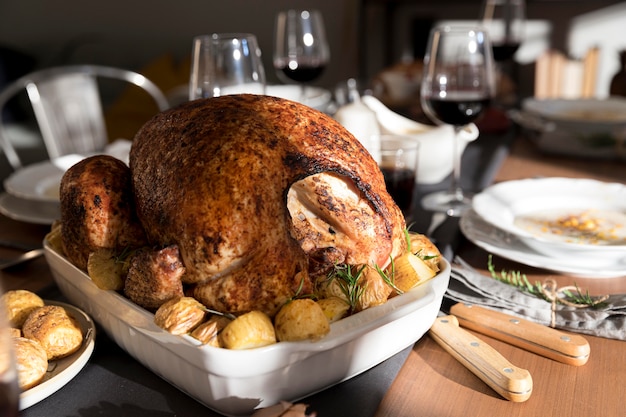(Part 1) Sizing Up the Beast:
First things first, let's take a good look at our feathered friend. A 23-pound turkey is no dainty morsel. It's a culinary behemoth that demands respect and a well-thought-out plan. The key is to understand that this bird requires a substantial amount of time to cook through, ensuring every bit of meat is juicy and succulent.
(Part 2) The Golden Rule of Turkey roasting time:
The classic rule of thumb for roasting turkeys is 15 minutes per pound at 325°F (165°C). Now, for a 23-pound bird, that translates to a whopping 345 minutes, or a little over five and a half hours. But hold your horses! This is just a starting point, and there are a few factors that can significantly influence cooking time.
(Part 3) The Big Factor: Turkey Size:
Let's be honest, a 23-pound turkey is a lot bigger than a smaller bird. It's simply common sense that a larger bird will take longer to cook. Think of it this way: the heat needs to reach the center of the bird, and that takes time. With a larger bird, there's more distance to cover, so it's going to require a longer roasting time.
The turkey roasting Time Calculator

Instead of relying solely on the classic rule of thumb, a turkey roasting time calculator is your best friend. You can find plenty of free calculators online, like the one on the USDA website or the one on the website of your favorite food magazine. These calculators take into account several factors, including the weight of your turkey, your oven's temperature, and even whether you're stuffing it.
(Part 4) The Importance of Temperature:
cooking a turkey is all about the temperature. The temperature inside the turkey needs to reach a safe 165°F (74°C) to ensure all potentially harmful bacteria are killed. This is why a meat thermometer is absolutely essential. Don't rely on guesswork or your grandma's old trick of poking it with a fork! Invest in a good quality meat thermometer and use it regularly to check the internal temperature of your turkey throughout the roasting process.
(Part 5) Roasting a stuffed turkey:
Ah, stuffing, the subject of many heated debates. Some people swear by it, others swear against it. Personally, I prefer to stuff separately. I find that it allows for better control over the cooking process. You can be sure the stuffing reaches a safe temperature without compromising the turkey's cooking. If you're determined to stuff your turkey, you need to factor in extra time. The stuffing needs to reach 165°F (74°C) just like the turkey itself, and that takes longer because it's packed inside the bird.
(Part 6) The Truth About Turkey Roasting Time:
Let's be honest, figuring out the perfect roasting time is a bit of a dance. You want your turkey to be perfectly cooked, but you also don't want to end up with a dry, tough bird. The best approach is to start with the calculator's estimated time and check the temperature regularly, adjusting the roasting time as needed. It's a bit like playing it by ear.
The Turkey Roasting Timeline

Here's a general timeline to get you started, but remember that this is just a guideline. You'll need to adjust based on your turkey's size and your oven's temperament:
| Time | Process |
|---|---|
| First 30 minutes | Roast at 325°F (165°C) without covering |
| Next 2.5-3 hours | Reduce heat to 300°F (150°C) and cover with foil |
| Last 30 minutes | Uncover and raise temperature to 350°F (175°C) to brown the skin |
This method helps ensure even cooking. Roasting uncovered for the first 30 minutes allows the skin to get a nice crisp. Reducing the heat and covering the turkey with foil prevents it from drying out, while the final 30 minutes uncovered helps brown the skin for a beautiful golden finish.
(Part 7) Don't Overcook It:
Remember, it's better to err on the side of undercooked than overcooked. A turkey can always be cooked a little longer, but you can't bring it back from being dry and tough. Overcooked turkey is a culinary tragedy, a sad reminder of a missed opportunity. So, it's crucial to keep a close eye on the temperature and make sure you don't overdo it.
(Part 8) Signs of a Perfectly Cooked Turkey:
There are a few telltale signs that your turkey is reaching its peak of culinary perfection:
- The juices run clear when you poke the thickest part of the thigh. This indicates that the turkey is cooked through and the meat is no longer pink.
- The skin is golden brown and crispy. A beautiful, golden brown skin is a sign that the turkey has been roasted properly and the fat has rendered nicely.
- The drumstick moves freely when you jiggle it. This is a good indication that the meat is tender and cooked through. If the drumstick feels stiff, the turkey might need a little more time.
- The thermometer registers 165°F (74°C) in the thickest part of the thigh. This is the ultimate test. Make sure you insert the thermometer deep into the thigh, not just the skin.
(Part 9) Resting Time:
Once your turkey has reached its glorious peak, don't rush to carve it. Let it rest for at least 30 minutes before carving. This allows the juices to redistribute throughout the meat, ensuring a juicy and tender bird. It's a crucial step that is often overlooked, but it makes all the difference in the world.
FAQs

What should I do if my turkey is cooked but the stuffing isn't?
If your turkey is perfectly cooked, but the stuffing needs a bit more time, don't panic. Remove the stuffing and bake it in a casserole dish at 350°F (175°C) until it reaches 165°F (74°C). You can also add a little bit of broth or stock to the casserole dish to keep the stuffing moist.
How long can I keep a cooked turkey in the fridge?
You can store a cooked turkey in the fridge for up to four days. Make sure to store it in a container or wrapped tightly in plastic wrap.
Can I freeze a cooked turkey?
Yes, you can freeze a cooked turkey for up to two months. Wrap it tightly in freezer-safe wrap or foil, and label it with the date.
What should I do with leftover turkey?
The options are endless! You can make sandwiches, salads, soups, casseroles, or even turkey pot pie. Get creative and enjoy the delicious leftovers.
Is it safe to eat turkey that's been left out at room temperature for a long time?
No, it's not safe. Bacteria can grow rapidly in food that's left out at room temperature, so it's best to refrigerate cooked turkey within two hours of cooking.
(Part 10) Final Thoughts:
Roasting a 23-pound turkey might seem daunting, but with a bit of planning, patience, and the right tools, you can create a culinary masterpiece. Remember, it's all about the temperature, timing, and a little bit of trust in your own abilities. Don't be afraid to check on your turkey, use a meat thermometer, and enjoy the process. And remember, you can always ask for help! Happy roasting!
Everyone is watching

Prime Rib Roast Cooking Time Chart: Per Pound Guide
Cooking TipsPrime rib roast. Just the name conjures images of lavish dinners, crackling fires, and hearty laughter. It’s ...

How Long to Bake Potatoes in the Oven (Perfect Every Time)
Cooking TipsBaked potatoes are a staple in my kitchen. They're incredibly versatile, delicious, and surprisingly easy to m...

Perfect Rice Every Time: The Ultimate Guide to Cooking Rice
Cooking TipsAs a self-proclaimed foodie, I've always been a bit obsessed with rice. It's the foundation of countless cuisi...

The Ultimate Guide to Cooking Asparagus: Tips, Techniques, and Recipes
Cooking TipsAsparagus. The mere mention of this spring delicacy conjures up images of vibrant green spears, crisp and burs...

Ultimate Guide to Cooking the Perfect Thanksgiving Turkey
Cooking TipsThanksgiving. Just the word conjures up images of overflowing tables laden with delicious food, the scent of r...
